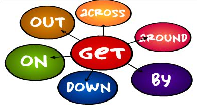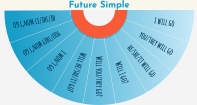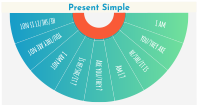Change Avatar
Simple Present Tense
Simple Present Tense
What is a verb tense?
A verb tense tells us when the action happened - an action or past state of being (i.e. a to be verb).
There are 3 simple verb tenses we are going to learn about:
#1 - Present tense means something that is happening NOW!
#2 - Past tense means that something already happened.
#3 - Future tense means something is going to happen in the future.
HINT! What’s a to be verb? Here’s a reminder:

What is Simple Present Tense?

Present tense means something is happening right now. It can also mean things that repeatedly happen or general things that you always do, like a routine or a habit.
Examples:
• I Slide down the slide.
• You smell the flowers.
• We look at books.
Repeated Actions:
These can happen anytime in the past, present, or future, but the simple present tense is used to describe things you do repeatedly or as a habit.
Examples:
• Joey eats vegetables to stay healthy.
• Sarah exercises to keep her body strong.
• I like chocolate.
Generalizations:
Generalizations means something that is a constant or reality. They are formed using linking verbs with to be.
Examples:
• I am happy.
• You are very smart.
• Our family is large.
How do you form the Simple Present Tense?
In general, most regular verbs use the root word as it is when in present tense.
The exception to that is when you’re in the 3rd person singular (he, she, it), which is when you add -s to the end of the root word.
Here is a chart that helps you see the different person formats for different root words:
DRAW
| Singular | Plural | |||
|---|---|---|---|---|
| 1st Person | I | draw | we | draw |
| 2nd Person | you | draw | you (all) | draw |
| 3rd Person | he / she / it | draws | they | draw |
COOK
| Singular | Plural | |||
|---|---|---|---|---|
| 1st Person | I | cook | we | cook |
| 2nd Person | you | cook | you (all) | cook |
| 3rd Person | he / she / it | cooks | they | cook |
PLAY
| Singular | Plural | |||
|---|---|---|---|---|
| 1st Person | I | eat | we | eat |
| 2nd Person | you | eat | you (all) | eat |
| 3rd Person | he / she / it | eats | they | eat |
Are there exceptions to that rule?
Yes! When the root word ends in o, z, ch, sh, th, ss, or gh, you will add -es to the end of the 3rd-person singular.
GO (ends in -o)
| Singular | Plural | |||
|---|---|---|---|---|
| 1st Person | I | go | we | go |
| 2nd Person | you | go | you (all) | go |
| 3rd Person | he / she / it | goes | they | go |
TEACH (ends in -ch)
| Singular | Plural | |||
|---|---|---|---|---|
| 1st Person | I | teach | we | teach |
| 2nd Person | you | teach | you (all) | teach |
| 3rd Person | he / she / it | teaches | they | teach |
STRESS
| Singular | Plural | |||
|---|---|---|---|---|
| 1st Person | I | stress | we | stress |
| 2nd Person | you | stress | you (all) | stress |
| 3rd Person | he / she / it | stresses | they | stress |
How do you make the Simple Present Negative?
To make the simple present negative, you use:
DO + NOT + root form of verb
DOES + NOT + root form of verb
Examples - You do not like to read.
It does not like its new food.
or you can use the contractions
Examples - She doesn’t like to sleep.
I don’t care for chocolate.
To make to be verb (see above) negative, you just add the word NOT after the correct form of the verb.
Examples - I am not a swimmer.
He is not a fan of baseball.
How do you ask a question in the simple perfect tense?
It’s easy! Just use:
DO/DOES + subject (noun or pronoun) + root form of verb
Examples - Do you know where they keep the markers?
Does Joey eat breakfast?










